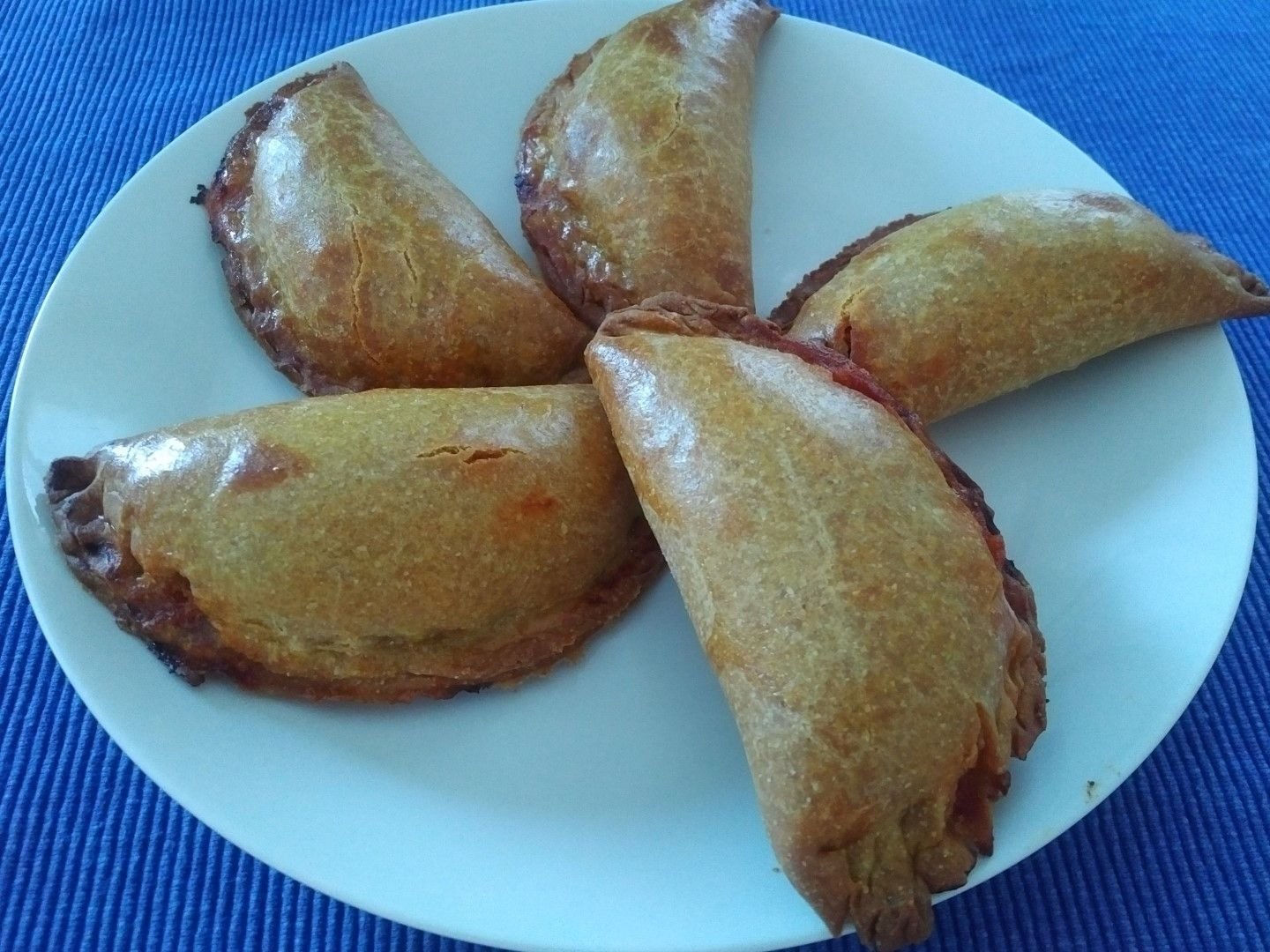Empanadas de atún, or tuna empanadas, are a classical dish from Spain. You might be more used to seeing the Argentinian version which is usually filled with meat rather than fish (tuna). Usually the crust of these savoury pastries is made from plain white (wheat) flour and often they are fried rather than baked in the oven.
Over the years, I went from making these the traditional way to replacing the white flour with wholewheat and then, later, with whole spelt flour, but always rigorously baked in the oven. Recently though, during my experiments with other flours, I replaced the whole spelt with organic chickpea flour and the results were just as good. In fact, they were crispier on the outside.
This recipe contains no other fat than olive oil, and the crust is easy to make. It is not the quickest of recipes mainly due to the preparation of the filling, but you’ll be glad to know they freeze well so you can make a whole batch ahead and store them in the freezer individually or in batches. They are perfect as a starter (you can make mini empanadas as finger food), as a main accompanied by some fresh salad greens, or for picnics and packed lunches.
Tuna Empanadas in Chickpea Crust
Ingredients
For the crust:
110g natural mineral water (room temperature)
110g olive oil
325-350g organic chickpea flour
½ tsp salt
For the filling:
2 boiled eggs, shell removed
1 large handful of anchovy-stuffed green olives
180g (1 can) drained tuna in olive oil
500g tomato sauce
For the glazing:
1 extra egg for glazing
Method
1. Mix the salt, water and olive oil in a large glass bowl.
2. Measure and add the chickpea flour (start with 325g, you can add more as needed) to the bowl. Mix well, first with a knife, then with your hands. You should obtain a slightly sticky ball of dough. If it feels too wet, you can add a little flour. If it is too dry and starts crumbling, add some more olive oil. Remember that chickpea flour doesn’t have the gluten like plain wheat flour, so it will dry and crumble more easily. Also, the chickpea will absorb the oil quite easily and quickly, so use your instinct to add more oil or flour as needed.
3. Once you have achieved the right dough consistency, shape it into a ball, wrap this with some cling film and place in the fridge for 30 minutes to 1 hour.
4. In the meantime prepare the filling. (This can also be done ahead and stored in the fridge overnight). Boil the 2 eggs in a pan, covering them with cold water and setting the timer for 15 minutes. Then remove from the heat and allow to cool slightly in the pan before scooping them out and peeling them.
5. Cut the olives into slices and drain the tuna. Set aside.
6. Cook the tomato sauce in a frying pan for about 15 to 20minutes so it begins to reduce.
7. Cut the boiled egg into small 1-2 cm chunks, and add these to the tomato sauce with the other ingredients. Separate the tuna chunks into smaller pieces while you mix.
8. Cook for another 5 minutes so that it all amalgamates well and the tomato sauce has reduced and any excess liquid has evaporated. If the sauce is too runny it will make the crust soggy.
9. Turn off the heat and set aside to cool.
10. Preheat the oven at 180°C and line an oven tray with greaseproof paper.
11. Take out the dough from the fridge and divide it into smaller batches, 3 to 4. Lightly dust a clean, cool surface with some flour (you can use some wholewheat spelt for this) and roll out each batch to approx 2mm thickness.
12. Using a pastry cutter, or a small round bowl and a knife, cut some circles of approximately 15 cm in diameter. You can use the cuttings and re-roll them until all the dough has been used. Depending on the thickness of your rolled out dough and the diameter of each empanada you should get about 8 to 10 pieces. (Chickpea flour is more difficult to handle as it will crumble more easily, but once you get the hang of it it’s just as simple, just handle with care.)
13. Place the circles of dough on the oven tray. Using a teaspoon, place enough filling to cover half the circle, leaving space around the edge to seal the dough. Then fold over the other half circle of dough to cover the filling, and press firmly down, all the way around the edge, to seal the case well. You can then pinch the edge to finish it off. Do this for each empanada.
14. Leave some space between empanadas on the tray so they have space to rise slightly.
15. Beat the remaining egg in a bowl and brush to glaze the tops.
16. Place in the oven for approximately 20 to 25 minutes. Serve slightly warm.
A variation of the above recipe can be made by also adding some finely chopped red bell pepper to the filling.
This recipe is just another example of how you can take a classical recipe and make it healthier with just a couple of easy tweaks. Don’t be afraid to experiment with other flours and swapping ingredients.
Happy healthy eating!


